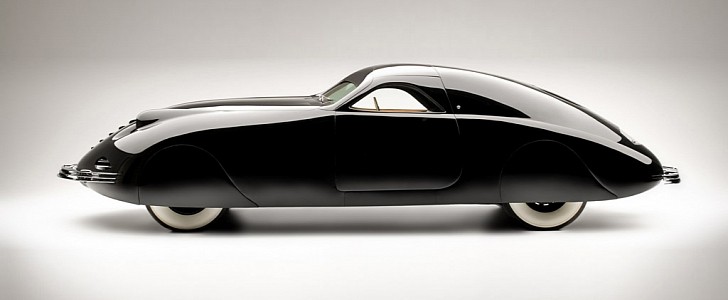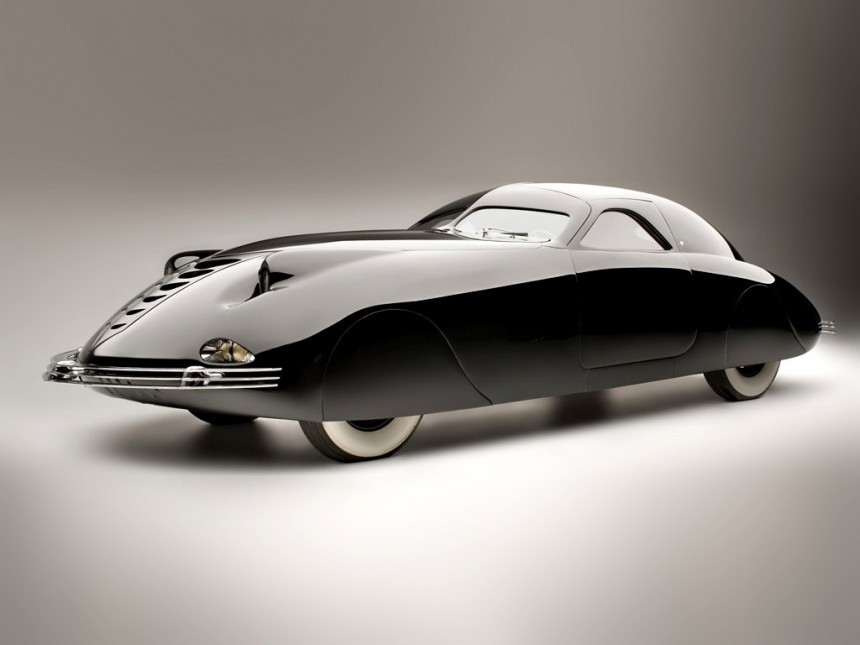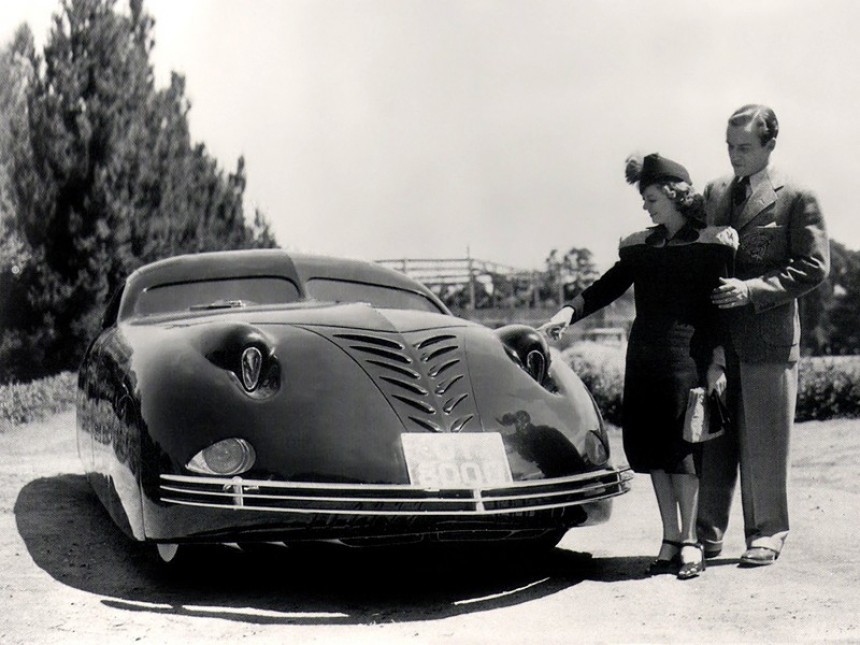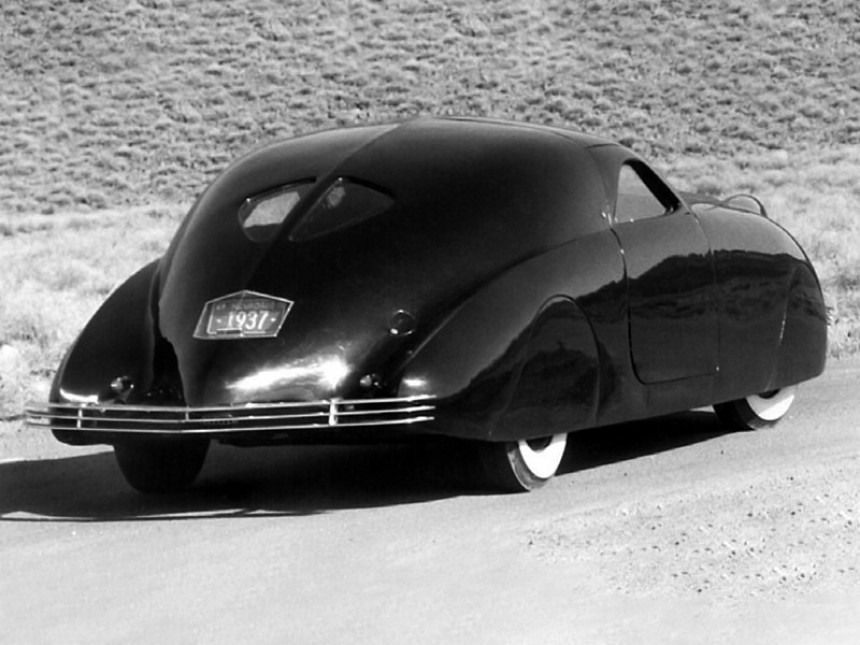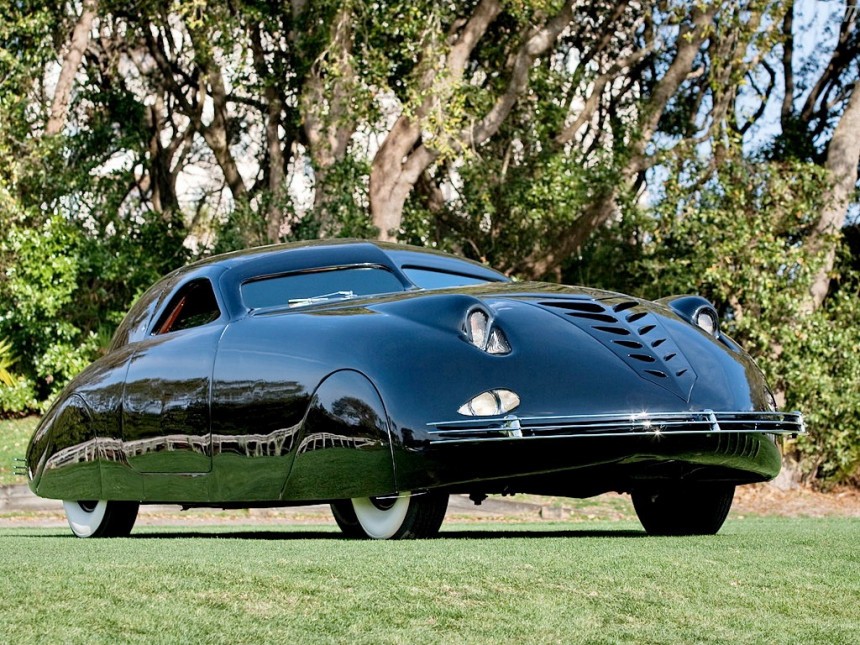Produced in 1938, the Buick Y-Job is widely regarded as the world's first concept car. While that might not be true (Auburn and Volvo built concepts before Buick did), the Y-Job is often considered the wildest pre-WW2 automobile in terms of design and technology. But that's true only until you take a look at the Phantom Corsair.
Also introduced in 1938 (it's unclear whether it debuted before or after the Y-Job), the Corsair was designed by Rust Heinz and Maurice Schwartz. The former was the grandson of H.J. Heinz, founder of the Heinz food processing company (yes, I'm talking about the ketchup). The latter owned Bohman & Schwartz, a coach building business in Pasadena.
In an era when production cars still featured individual fenders and running boards, the Phantom Corsair debuted with completely flush body panels, fully skirted wheels, and integrated headlamps.
It was quite long at 19.75 feet (6,020 mm) from bumper to bumper, but the chopped roof design and the flowing beltline gave it a sleek appearance.
But the Corsair also looked unusual, even when compared to expensive, coach-built cars of the late 1930s. The V-shaped, body-colored front grille and the "frog-eye" headlamps gave it a front fascia that only Batman could love.
Quirky looks aside, the prototype was loaded with innovative, industry-first features. The doors lacked conventional handles, featuring electric push-buttons instead. These were located on the wide B-pillars and the dashboard.
A console mounted above the windshield indicated when the headlamps or radio were turned on and also signaled when a door wasn't completely shut.
But the Corsair had even more surprises inside the cabin. Despite its sleek appearance and two-door layout, the Phantom provided seating for up to six people. This wasn't unusual at the time because most cars had a three-person front bench, but the Corsair had a never-before-seen 4+2 layout.
At 76.5 inches (1,943 mm) wide, the concept was designed to accommodate four people in the front row. And get this, one person would sit to the left of the driver. Granted, a fully packed Phantom would have made the driver's trip an uncomfortable ordeal, but it's an interesting approach to grand touring.
The rear compartment provided room for only two passengers. The unusual setup had to do with the fact that the second-row seat was flanked by onboard beverage cabinets.
While Heinz and Schwartz designed the body and the interior from scratch, the underpinnings were sourced from Cord. Founded in 1929, Cord Automobile had gone bankrupt in 1937, one year before the Corsair arrived, but Heinz was still able to get his hands on a chassis and an engine.
Both came from a Cord 810, a luxury coupe that went into the history books as the first American car with front-wheel drive and independent front suspension. It also featured adjustable shock absorbers.
Motivation came from a 287-cubic-inch (4.7-liter) Lycoming V8 of the L-head variety. Rated at 125 horsepower and connected to an electrically operated, four-speed pre-selector gearbox, the V8 pushed the Cord 810 to a top speed of 93 mph (150 kph).
But due to its aerodynamic shape, the Phantom Corsair could achieve speeds of up to 115 mph (185 kph). That's almost as much as the supercharged (and significantly more powerful) Cords and Duesenbergs of the era.
The Phantom Corsair cost Heinz a whopping $24,000 to build in 1938, which converts to almost $450,000 in 2021. Despite the prohibitive production costs, he planned a limited-production run for the Corsair at $12,500 a pop. About as much as a Duesenberg.
Unfortunately, Heinz died in a car accident in July 1939, and the project was abandoned, leaving the prototype Corsair as the only one ever built.
So what happened to the one-off Phantom? Well, amazingly enough, the sleek and weird Corsair survived to this day, and it can be admired in the National Automobile Museum in Reno.
Do you still think that the Y-Job was the wildest concept car of the 1930s?
In an era when production cars still featured individual fenders and running boards, the Phantom Corsair debuted with completely flush body panels, fully skirted wheels, and integrated headlamps.
It was quite long at 19.75 feet (6,020 mm) from bumper to bumper, but the chopped roof design and the flowing beltline gave it a sleek appearance.
Quirky looks aside, the prototype was loaded with innovative, industry-first features. The doors lacked conventional handles, featuring electric push-buttons instead. These were located on the wide B-pillars and the dashboard.
A console mounted above the windshield indicated when the headlamps or radio were turned on and also signaled when a door wasn't completely shut.
But the Corsair had even more surprises inside the cabin. Despite its sleek appearance and two-door layout, the Phantom provided seating for up to six people. This wasn't unusual at the time because most cars had a three-person front bench, but the Corsair had a never-before-seen 4+2 layout.
The rear compartment provided room for only two passengers. The unusual setup had to do with the fact that the second-row seat was flanked by onboard beverage cabinets.
While Heinz and Schwartz designed the body and the interior from scratch, the underpinnings were sourced from Cord. Founded in 1929, Cord Automobile had gone bankrupt in 1937, one year before the Corsair arrived, but Heinz was still able to get his hands on a chassis and an engine.
Both came from a Cord 810, a luxury coupe that went into the history books as the first American car with front-wheel drive and independent front suspension. It also featured adjustable shock absorbers.
But due to its aerodynamic shape, the Phantom Corsair could achieve speeds of up to 115 mph (185 kph). That's almost as much as the supercharged (and significantly more powerful) Cords and Duesenbergs of the era.
The Phantom Corsair cost Heinz a whopping $24,000 to build in 1938, which converts to almost $450,000 in 2021. Despite the prohibitive production costs, he planned a limited-production run for the Corsair at $12,500 a pop. About as much as a Duesenberg.
Unfortunately, Heinz died in a car accident in July 1939, and the project was abandoned, leaving the prototype Corsair as the only one ever built.
Do you still think that the Y-Job was the wildest concept car of the 1930s?
